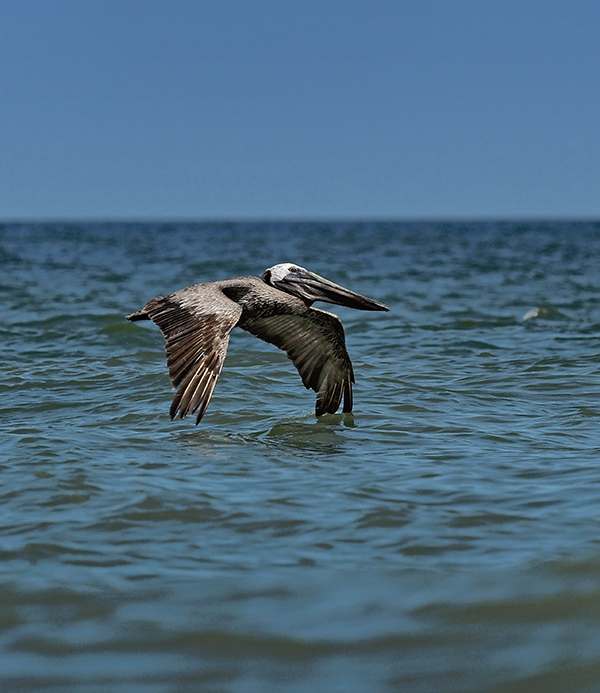A full-frame Olympus? Not just no: *HECK* no! (And why Olympus is better off for it)
posted Wednesday, December 12, 2018 at 1:12 PM EDT
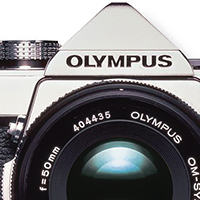
When Panasonic announced the development of their full-frame mirrorless system at Photokina 2018 back in September, it left a lot of people wondering what that meant for the future of the Micro Four Thirds system, with understandable cause for alarm.
The Micro Four Thirds system was jointly developed by Olympus and Panasonic back in 2008, and while a few other companies make niche-market camera bodies based on the standard, the vast bulk of production has been split between these two original founders.
When they announced the L-mount alliance alongside partners Leica and Sigma, Panasonic said that they'd continue to support and develop products for Micro Four Thirds. But it's an easy bet that a lot of their R&D dollars are going to be spent on developing L-mount bodies and lenses for at least the next few years. What's more, besides Panasonic's publicly-announced shift in focus, it's now been almost two years since Olympus released their last flagship model for their line, the E-M1 Mark II, and over a year since they released the lower-end E-M10 III.
So where does that leave Micro Four Thirds? With all the focus on full-frame mirrorless of late, will Olympus bow to market pressure and develop a full-frame product line as well?
An Olympus full-frame? "HECK no..."
I had a chance to sit down for an extended chat on this very topic with Aki Murata, Olympus America's new VP of sales and marketing during the Photo Plus show in late October. (Yes, it's taken this long for me to finally find time to write this up :-/) Murata-san was appointed to his current position back in April of this year, after a stint as Olympus' Global Marketing Manager and a long stay with Olympus Germany before that. This was the first chance I'd had to talk with him, so it was interesting to hear his thoughts on recent changes and Olympus' future.
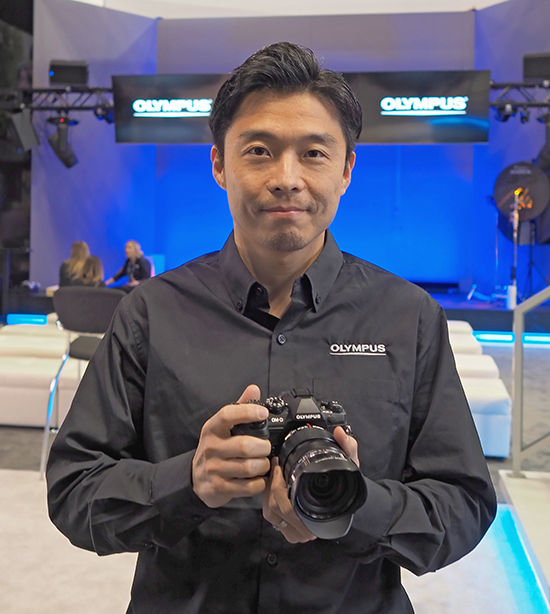
Murata-san laid out Olympus’ strategy of small, lightweight, and “ultimately reliable” cameras when I met with him at PhotoPlus back in late October.
Per the headline, Murata-san's response to my question on whether there might be full-frame cameras in Olympus' future wasn't just no, but really, seriously no! He not only made a very strong business case for not doing so, but explained that Micro Four Thirds is actually a direct expression of an overarching product strategy Olympus has been executing on for over 50 years.
Olympus' "compact" DNA
Way back in 1970, legendary camera designer Yoshihisa Maitani set out the philosophy that would define the future of the company in a detailed, handwritten document. (Of course it was handwritten; this was in the early 1960s, so there weren't any word processors around. But he wrote it himself in a notebook, vs dictating it to an assistant.) So many decades ago, Maitani set out a philosophy of compactness, light weight, and "ultimate reliability" for Olympus' cameras, a direction they've followed ever since.
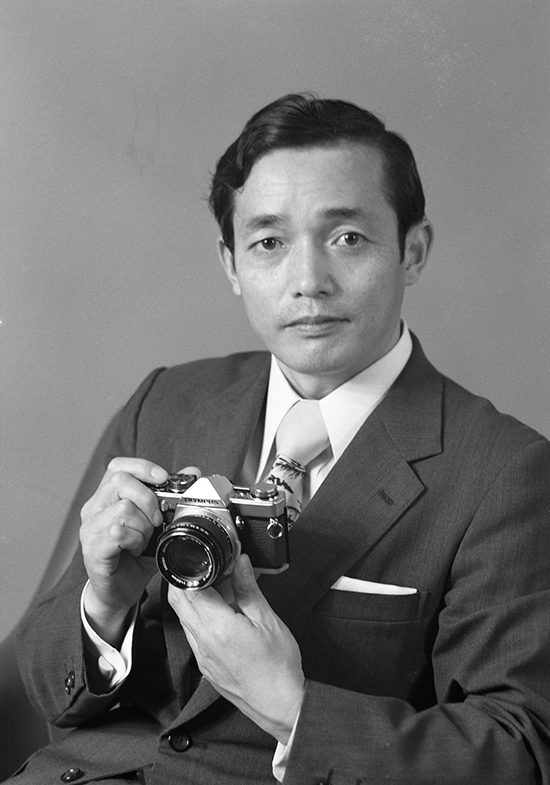
Yoshihisa Maitani’s illustrious career with Olympus spanned forty years, from 1956 to 1996. Even today, the design principles and philosophy he established continue to guide Olympus’ strategy and product direction.
It's interesting that after all these years, Micro Four Thirds is just the latest expression of the same fundamental corporate DNA that led to the original OM-1 system back in 1972, and even the PEN series of half-frame 35mm cameras first announced in 1959. (In fact, Maitani was so revered within Olympus that the "OM" in the OM-1 model name stood for Olympus-Maitani. It's almost unheard of for a Japanese company to elevate a single individual to such status.)

The four quadrants of photography
Relative to their ongoing strategy, Murata-san described a view of photography that divided subject matter along two axes, indoors vs outdoors in one direction, moving vs still subjects in the other. To help understand the concept, I've made the rough diagram below, where a few different types of photography are shown, with the size of the circles indicating approximate market size. (I don't know how big the different markets actually are, but I do recall Murata-san noting that Nature and Wildlife was a huge category, much larger than some others that I would have expected to be bigger.)
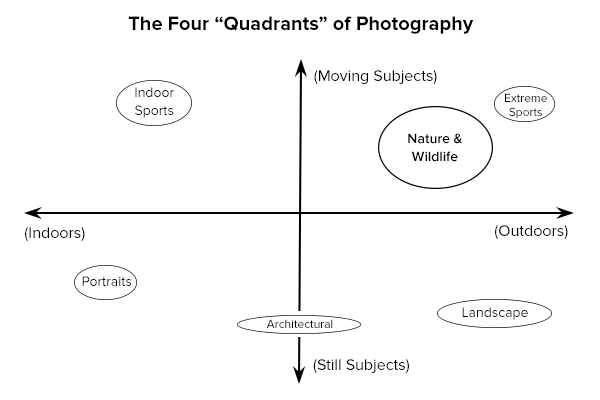
Picking just a few of the many types of photography that Murata-san mentioned, Nature and Wildlife photography (the size of which frankly astonished me) involves shooting moving subjects outdoors, so it's in the upper right-hand quadrant. In contrast, Landscape photography takes place outdoors, but with static subjects (apart from earthquakes, landslides and volcanoes :-), so it's in the lower right quadrant. Looking to the other quadrants, Portrait photography takes place indoors, with static subjects, so it's in the lower left quadrant. Finally, arena and indoor sports (think Basketball or Hockey) involve moving subjects, shot indoors, so they're in the upper left quadrant.
When you think of the kind of gear you'd most like to use for shooting any of these, indoor situations don't call for ruggedness or weather sealing. Indoor sports does call for sure-footed autofocus, though, and the lower light levels there often demand exceptional high-ISO capability.
Landscape photography happens outdoors, so will sometimes call for a rugged, weather-sealed body and lens. The subject isn't moving around a lot, though, so autofocus isn't as much of an issue. Ditto Architectural photography, usually minus the weather-sealing element.
Camera and system size usually aren't issues for indoor shooting scenarios, and applications like Architectural photography are similar. (Landscape photography could go either way, size-wise: Sometimes you'll be near a road or shooting from an easily-accessible location, but other times, you'll be packing your gear in a backpack, to get to the backcountry.)
(Credit to Dave Pardue, our in-house Pelican expert ;-)
Murata-san's point in describing this segmentation was to note that Olympus' natural market is in the outdoor/moving-subject quadrant (the upper right one in my rough diagram above). Having a compact, lightweight, rugged system is seriously important for Nature and Wildlife photographers, and the smaller sensor size of Micro Four Thirds is a significant advantage. The difference between carrying a full-frame DSLR with a 600mm f/4 lens vs a Micro Four Thirds body and Olympus' excellent 300mm f/4 (600mm eq.) is enormous. (And yes, hopefully heading off some of the flaming comments below, I know that the DOF of a 300mm f/4 on a Micro Four Thirds body is going to be greater than that of a 600mm f/4 on a full-frame body. When it comes to exposure though, f/4 is f/4, so the Olympus 300mm will give you the same shutter speeds as a 600mm f/4 on a full-frame body.)
Compact and portable: Olympus' unique position
While it seems that almost everyone else in the business is chasing after full-frame mirrorless (Fujifilm and Ricoh excepted) Murata-san made the point that those other players are in the process of leaving behind an important and very significant segment, namely people for whom compactness, light weight and ruggedness are supremely important.
While modern full-frame camera bodies can be quite compact, the lenses that go along with them are a lot larger than their Micro Four Thirds counterparts, especially as you get to telephoto focal lengths. All else being equal, a bag full of full-frame lenses is going to be a lot bigger and heavier than one packed with the Micro Four Thirds alternatives.
(For some examples of how full-frame rigs compare to Micro Four Thirds ones for overall weight, read IR Managing Editor Dave Pardue's take on "Confusion in the Camera Industry", written at the end of October, 2018.)
And then there's weather-sealing...
We at IR have been devoting a lot of time and effort recently towards developing well-controlled, repeatable weather-sealing tests that are also representative of real-world conditions. That's still a work in progress, but after talking with many camera manufacturers, Olympus clearly stood out for the level of weather-testing they subject their cameras to.
I've spoken with senior mechanical designers at a number of companies while working towards our own weather-testing protocol. While most of those discussions were under non-disclosure agreements, Olympus did give me permission to describe their weather-sealing test procedures, likely because they go to such extremes to make sure their high-end bodies are well-sealed.
Full details are a topic for another, much longer article, but the short story is this: For bodies like the E-M1 Mark II, Olympus uses the amount of water specified by the IPx1 standard (roughly 2.5 inches per hour, a heavy downpour in real-world terms), but rather than the 10 minutes of exposure specified by the ISO water-resistance test, they expose the bodies to that amount of water for 10 minutes per side. That is, they give it 10 minutes with the camera pointed to the front in landscape mode, left and right portrait modes, with the camera facing down, with it facing straight up, and with it upside down. That's a total of 60 minutes of heavy water exposure.
After its soaking, they determine whether the camera passed or failed by disassembling it (being very careful that no water that was on the outside of the camera ended up on the inside, as a result of their disassembly) and inspecting it carefully to see if there's any sign of water inside. If they find any water inside, that counts as a fail, and they figure out where it came from and how to block it the next time.
(As many of our readers likely recall, the Olympus E-M1 II passed our "Water Torture Test" with flying colors just one year ago.)
Go where the competition isn't
The upshot of all this is that the very market segment that all the other makers seem to be fleeing (compact, lightweight and rugged) is exactly the one most in line with Olympus' long-term philosophy and its current products.
Rather than being concerned that they can't compete in a world dominated by full-frame camera systems, Olympus is rejoicing that the competition has left them with a huge market segment virtually to themselves.
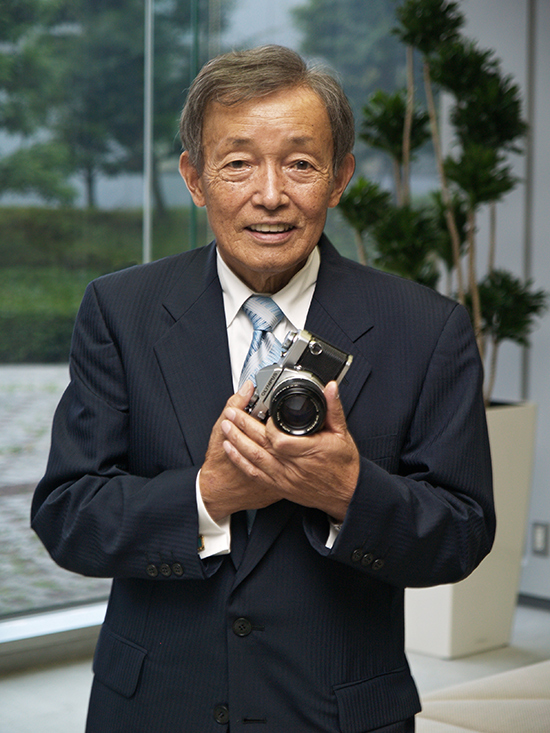
While there's certainly nothing to prevent you from lugging a 600mm lens and full-frame body on your next birding expedition (other than the bulk, weight, and insane expense), a compact, rugged, highly weather-resistant body like the E-M1 Mark II and Olympus 300mm f/4 will make a lot more sense for most people who need that kind of reach in the wild.
But can Micro Four Thirds remain viable, with just one camera maker in the game?
A lot of IR readers and others I've talked to in the industry have expressed concern over whether Micro Four Thirds can survive as a platform, with only Olympus continuing to invest strongly in developing new bodies and lenses for it. (Again, Panasonic says they're going to continue investing in Micro Four Thirds, but we expect to see their pace of MFT development slacken some over the next few years, given the heavy investment they're going to have to make in the new L-mount platform.)
Despite Panasonic's likely retreat, though, I don't see any sort of problem for Olympus and Micro Four Thirds in general. MFT already has arguably the most extensive native lens lineup of any mirrorless platform, with options ranging from entry-level to no-holds-barred professional optics, across a wide range of focal lengths. When it comes to true "native" optics, MFT offers a wider range of genuinely excellent choices than any other mirrorless system on the planet.
And when it comes to bodies, we don't expect to see Panasonic back out of the market entirely; they'll almost certainly continue developing and selling at least some new models, particularly in their very successful GH-series line of video-oriented bodies. Meanwhile, Olympus will be pouring all of their development capability into making the best compact, rugged, highly-performant bodies they can, without having to divert any R&D funds to coming up with a second mount system. While they haven't announced a new body in a little while, their existing models are excellent (we're looking at you, E-M1 Mark II), and if any message came across in my conversation with Murata-san, it was that development continues apace and great things are in store for the future.
The bottom line
At the end of the day, I have to say that Olympus has the most clearly articulated product strategy of any manufacturer that I've talked to, and in some ways the greatest market security, given that they're addressing the needs of a huge swath of photographers in ways that no one else is doing.
It will be very(!) interesting to see where Olympus goes next with their line of Micro Four Thirds bodies, but I left my meeting with Murata-san with a greater sense of Olympus's long-term viability than I've felt in a long while.
That was his intention, of course, but I found myself agreeing with all of his clearly stated points.
So here's to the future of Micro Four Thirds, and we can't wait to see what Olympus delivers next!


